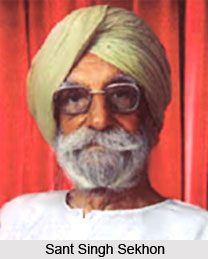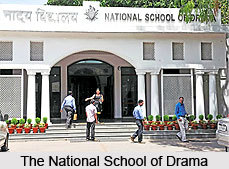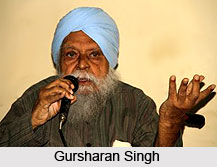 Punjabi theatre was developed to cater primarily to the urban middle class. The prime intent was to bring about social reform. Whatever the conflicts presented, these plays focused on the domestic and the romantic. The characters were generally stock types, and the climax proceeded on familiar lines. According to Sant Singh Sekhon, Punjabi theater in its early days was rhetorical, with emotions and sentiments having great importance. Following the partition, the theatre settled in areas like Shimla, Jalandhar, Patiala, Amritsar, Delhi, and, later, Chandigarh. Nowhere could it make its presence felt. In all these places, Punjabi theater remained a localized affair with no distinctive character of its own.
Punjabi theatre was developed to cater primarily to the urban middle class. The prime intent was to bring about social reform. Whatever the conflicts presented, these plays focused on the domestic and the romantic. The characters were generally stock types, and the climax proceeded on familiar lines. According to Sant Singh Sekhon, Punjabi theater in its early days was rhetorical, with emotions and sentiments having great importance. Following the partition, the theatre settled in areas like Shimla, Jalandhar, Patiala, Amritsar, Delhi, and, later, Chandigarh. Nowhere could it make its presence felt. In all these places, Punjabi theater remained a localized affair with no distinctive character of its own.
Later in the 1960`s the regional theatres in different parts attained maturity and professional skill. The National School of Drama, established in Delhi in the early 1960s, became a strong center for bringing about a purposeful dialogue among theater folks of the different regions of India. When Punjabi theatre came into contact with the theatre of other regions of India it found a new orientation in Punjab, Delhi and Mumbai.
It had an opportunity to avail itself of the services of well trained professional theater artists like Harpal Tiwana and his talented wife, Neena, Bansi Kaul, Suresh Pandit, Gurcharan Singh Channi, Devinder Daman, Sonal Mann Singh, Balraj Pandit, Kewal Dhaliwal, Kamal Tiwari Mahender, Navnindra Behal and Rani Balbir Kaur, who have brought into it a new vitality and vigor. The establishment of the departments of Indian drama and Asian theater at Punjab University, Chandigarh, and speech and drama at Punjab University, Patiala, under the guidance of two theater stalwarts, Balwant Gargi and Surjit Singh Sethi, respectively, has led to some bold experiments in theater.
In this very period, Punjabi theater started having its impact, for some of the theater groups made a serious effort to free themselves from the bonds of tradition. The Delhi Art Theater of Sheila Bhatia, Gursharan Singh`sAmritsar School of Drama, which later took the name of Chandigarh School of Drama after his moving to Chandigarh, Balraj Pandit`s Natakwala, and Atamjit Singh`s Kala Mandir, first at Amritsar and now at Mohali, have combined dramatic dexterity with ingenious devices while exploring new modes of expression on stage. Ajmer Aulakh has evolved a new, robust theatrical idiom from the folklore of Punjab. Devinder Daman and Jaswant Damanthe, a director-actress, husband-wife team, have, through their Norah Richards`s Rang Manch, introduced new modes of action in religious-historical plays.

From 1980, Punjabi theater passed through most difficult times. In this period, the people of Punjab suffered the most painful conditions of reckless killings and tensions between the two major religious groups of Punjab- Hindus and Sikhs. There was an atmosphere of total darkness and dissolution, with ever-increasing terrorist activity of looting and killings and fake police encounters, with women widowed and children orphaned.
Ironically, theater activity was triggered by militancy. Most of the theater groups concentrated on the Punjab problem and churned out scripts and staged plays on this problem. Gursharan Singh, the most notable of the artists, took his crisp, message-oriented plays from village to village and, in a loud voice, warned the masses of the dangers of religious fundamentalism. His plays written and enacted during this period were repeatedly applauded, enjoyed, and re-enjoyed by the common people. Ik Kursi, Ik Morcha te Hawa vich Latkde Lok (A Chair, an Agitation and People Hanging in Midair), Curfew, Hitlist, Baba Bolda Hai (The Old Man Speaks), Bhai Manna Singh, Chandigarh Puare di Jarh (Chandigarh, The Root Cause of Discord), and others were being staged at every corner of the state, and people in large numbers would witness these plays. There was no artistic quality in them, nothing that would make them a good example of professional theater, yet they had a sway on the people. Gursharan Singh himself does not boast their finesse, but he measures his success in terms of their delivery of a message. He represents the Janvadi (the people`s) movement in Punjabi theater.
Other theater artistes, such as Atamjit, took a different position. They do recognize the importance of a message, but for them theater is a unique art, it must be conceived in terms of dramatic metaphor, it must be transformed into a metaphorical mode of existence, and these metaphors should unfold meaning in a future-oriented movement of time. Therefore, there must be a significant experiment in form. His Seenan (Stitches) and Ajit Ram are not just tear-jerkers; they are mature pieces of new experimentation in form. Even his Rishtiyan da Ki Rakhiye Nan (How to Name the Kinship Relationships), staged by a number of theater groups, is found to be relevant to the communally charged atmosphere of the 1980s and early 1990s. An adaptation of Sadat Hassan Manto`s short story "Toba Tek Singh," it presents in spectacle the story of the country`s partition in an ironic mode.
 It is still a powerful story with which the people can identify even after 40 years.
It is still a powerful story with which the people can identify even after 40 years.
It will be interesting to note that, in spite of disturbed conditions, some good theater has also been possible. Sonal Mann Singh, Atamjit, Charan Das Sidhu (Delhi) Kewal Dhaliwal, Navnindra Behal and a host of other directors and producers are engaged in widening the vision. But still, drama and theater remain the weakest link in twentieth-century Punjabi literature. Punjabi theater is still not flourishing due to paucity of scripts, and very few playwrights can write good scripts. In their absence, the theater has to depend on adaptations and translations from other languages. There is no doubt that the new interest in theater in Punjab is here to stay, yet there is much to be done to improve the future of Punjabi theater.




















